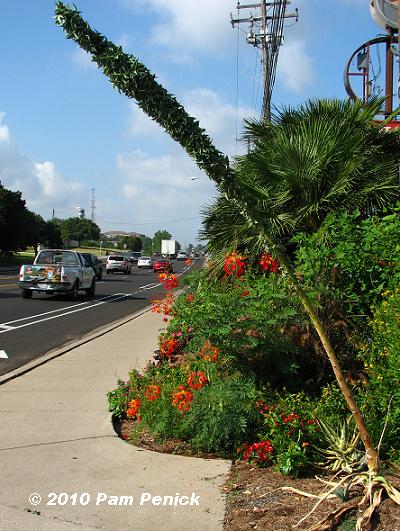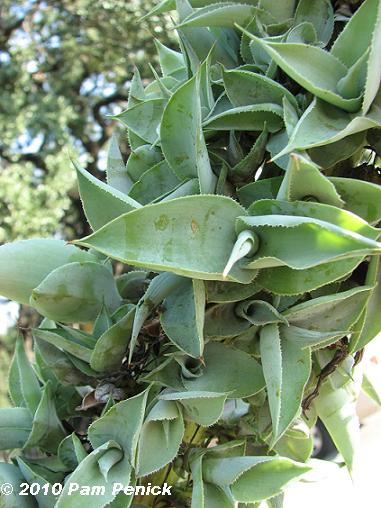Going out with a bang: Agave bloom spike with bulbils
At the Great Outdoors last week, I spotted this shriveled, dying agave holding up a 12-foot flower spike covered in bulbils, tiny clones of the mother plant. Most agaves bloom only once, after many years, and then die. Some, like this one, produce bulbils, which eventually fall to the ground. A few will take root and grow.
It’s a dramatic and fascinating reproduction process. For more images of bulbil-covered bloom spikes like this one, check out this post by The Germinatrix about her Agave wilmoriniana‘s phallic flowering. Or follow ESP of East Side Patch as he obsessively pots up several hundred bulbils from his dying agave.
Watching an agave grow for years and years and then go out with a bang can engender some intense reactions among the gardeners who love them. I will no doubt throw a whale-watching party when my beloved ‘Whale’s Tongue’ agave (A. ovatifolia) finally goes. Which I hope won’t occur for many years. I’m not ready for the Whale to set sail.
All material © 2006-2010 by Pam Penick for Digging. Unauthorized reproduction prohibited.




Great shots of the agave and the bulbils. I’ll never forget all those that Phillip had lined up for us when the bloggers visited his garden.
So I’m curious what you would think if you saw someone helping them-self to a bulbil or two? I have to admit I was so excited when I saw this very site in Santa Barbara last fall that I plucked a couple off. The agave was growing in a small strip mallish parking lot and it was obvious the plantings weren’t particularly cared for (I guess that is my rationalization). Plus there were just so many of them!!!
An ethical question related to bulbils–fun! Well, while I generally frown on helping oneself to seeds, cuttings, entire plants, etc., without invitation, a couple of bulbils from a neglected strip mall parking lot seems more like a rescue operation. What do other readers think? —Pam
Facinating to see how they produce these bulbils.
Ah – you KNOW how I love a good agave bloom! I’m dying to know what the mother was – the bulbils have toothed edges – hmmmm…
As for Loree’s foraging – I think that if the plant is on public property, and you leave the majority behind, foraging and gleaning succulent babies should be the same as gathering fruit – cool as long as good manners are observed. And Loree is such an agave fiend, I wouldn’t deny her a thing! Besides, so many of them don’t make it – so some of them go to a good home is great!
Thank you for the shout out, Pam! And I am hoping for years and years of Whale’s Tongue enjoyment before the Whale Watch has to happen! XOXOIvette
Hi Pam.
I hope I do not have another agave bloom any time in the near future…I do not know if I,(or my back) could go through that obsessive planting again anytime soon! Not to mention all the hurdling of the fallen stalk and tikki-torch limbo dancing that I participated in at that frantic time in my horticultural life. I transferred the pups that were root bound in their tiny pots all around the Patch this year, some into the hell strip, a swath down the side of my house and even more in the rear, oh yes the young ones will carry on their mother’s gene pool. 🙂
Thanks for the mention Pam.
May your tongue stay healthy for many a future year. (You don’t get to say that in a sentence every day)!
ESP.
Hello Pam,
I still do not get over my wonder when I see a beautiful Agave flowering. My Agave vilmoriniana bloomed 3 years ago and I saved some of the bulbils and replanted them.
That is fascinating. What kind of agave is this? Do all agaves bloom?
I’ve noticed many that my mother called ‘century plants’, blooming this summer. Could it be from the stress of our especially cold winter? I know…questions, questions.
The blooms are interesting, but when the plant dies, it usually leaves a huge hole in the landscape. The large ones are such architectural focal points.
I agree with ESP….may your tongue stay healthy for a long time.
Good questions, Linda. I don’t know what kind of agave this was. The mother plant was pretty dead, and it can be hard to ID pups. I believe that all agaves do bloom eventually, and nearly all are monocarpic, which means they bloom once and then die. Some live longer than others, but even the so-called century plant (Agave americana) usually lives only decades, not a century.
As for the century plants blooming this summer, I don’t know whether a cold winter tends to trigger blooming. I haven’t noticed any more than usual myself. And yes, they do leave a hole when they die. Those americanas, especially, are gigantic plants. —Pam
I could be wrong, as I am certainly not a ‘pup’ expert but I think it may be an Agave vilmoriniana or Octopus Agave that’s blooming.
Can you take a basket and sit under the agave when the bulbils fall? Loved the Great Outdoors post. Nice pots.
Hi, Pam. I was devestated when my agave went out with a bang after only 3 years. It was a dramatic, beautiful end to a very short life. It did not live up to it’s nickname of “century plant”. However, I saved some pups and replanted in her memory!
Whoa… i didn’t realize some of these stalks were covered in the pups! Most of the time they are so high up it’s hard to get a good look at what’s waving around up top. All of my specimens are relatively young, so i haven’t experienced the spike grief/celebration. I can’t help expecting I’ll be one of those who has strong reactions to those events, as I can’t help but name and mutter to my favorite plants. As a recent victim of some minor and pointless garden vandalism, I get my hackles up about helping oneself to plants. But i have to agree that pups dropped in a neglected parking lot situation are much like feral animal babies and deserve a chance too! I keep a bucket in my truck bed, because there have been quite a few instances where i’ve ‘rescued’ disgarded agave, aloe, and cactus plants from curbside piles and even dumpsters!
Hi Pam,
I can’t believe this…this very agave went out with a bang in my brother’s yard in College Station a number of years back. I couldn’t resist taking home the tons of babies. The babies are NOT very cold hardy. I’d say down to 25 degrees. A few were under leaves and protected. They made it even at 21 degrees. I have the 3 toughest left and they recovered nicely.
It’s a very unique color for an agave…Would color would you say? Almost seafoam green?
David :-)/Tropical Texana
P.S. BTW: I think there are two forms of Agave vilmoriniana…the fat leaf type (which is what my brother has and matches your picture) and the very thin octopus cultivar ‘Calamari’?). Check out the photos at San Marcos growers (image 2) and see what I’m talking about. I’ll try to take photos of both here in my garden, but the babies are not large enough for a fair comparison.
Thanks.